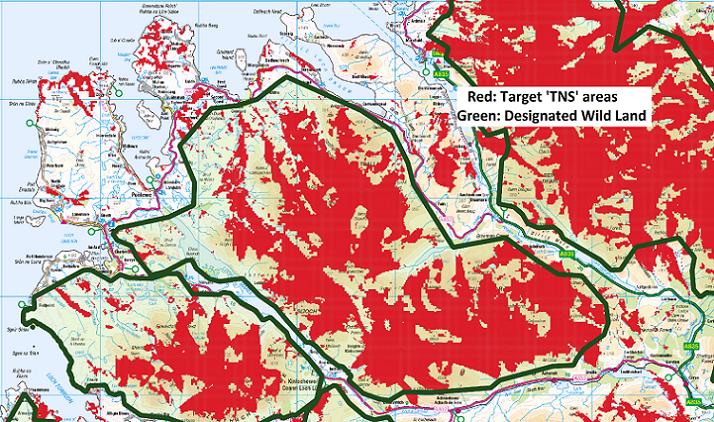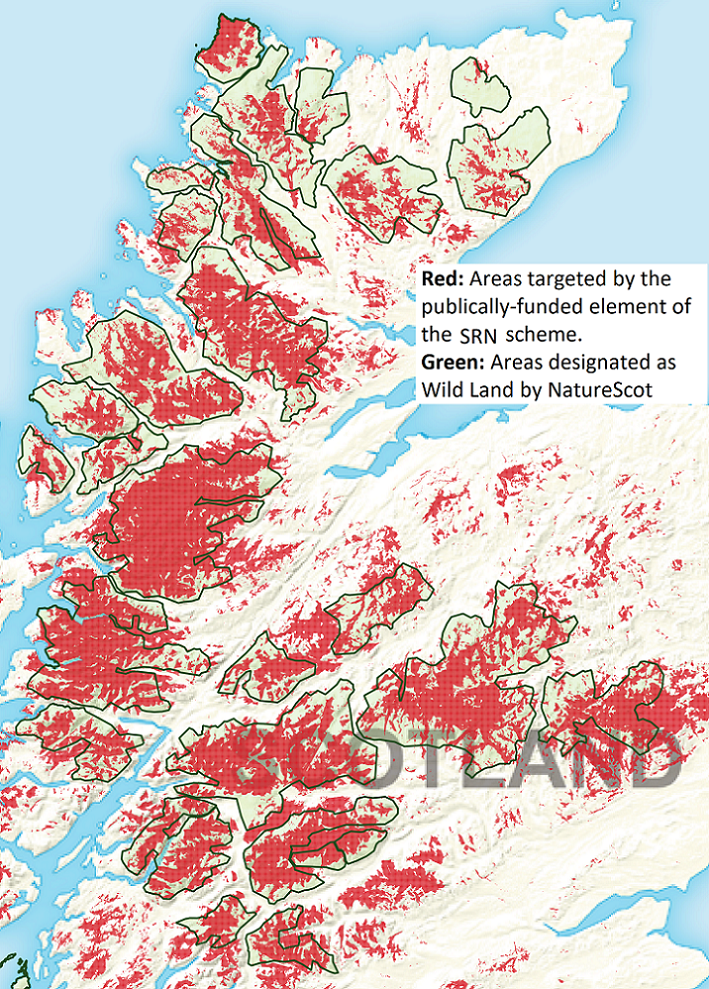Parkswatch has already featured the Shared Rural Networks (SRN) scheme, and some instances of its potential impact (see here), (here) and (here). Some digging (mostly by others) reveals that the potential impact of the SRN scheme is much bigger and much worse that many people previously thought.
To recap, the Shared Rural Networks (SRN) scheme is an initiative to provide better mobile telephone service to rural communities and businesses. This is essentially a GOOD THING. However, the scheme has set itself a goal of providing coverage to 95% of the UK land area. There’s a lot of money involved – £460 million from the current network providers, and £500 million from the UK Government. [Source: SRN website.] That’s a lot of money, so even if each mast costs £1M, that’s a lot of masts. The problem with the target is the 95% land area – not 95% of population.
The network providers are funding masts where there are people, leaving the empty areas to be funded by central government. Publicly-funded masts can only be sited in TotalNotSpot (TNS) areas, as defined by Ofcom in 2020.
The maps below show the impact on wild land. Green is the boundary of the Wild Land Areas recognised by the Scottish Government. Red shows the areas targeted for publicly-funded coverage. First, the Fisherfield area:

Second the whole of Scotland:

The conflict is obvious.
I have an email from the SRN authority, which I quote:
“The new masts proposed under the Shared Rural Network are to provide geographic coverage for these areas. Although there may be few or no premises in these locations, the masts will provide coverage for those who live and work in rural areas whilst away from a fixed address; as well as those visiting the area.
Even in areas where there are no premises, it is still essential to provide improved connectivity. Having the ability to access vital information and services is critical, as is the reassurance of being connected if there is an incident in these harder to reach places.”
I’ve underlined the important phrase. Mobile phones are essentially line-of-sight; wild land is where there is no significant visible human infrastructure. So, to paraphrase only slightly, the aim is that there should be no wild land anywhere in Scotland – and there is £940 million to back that up. You maybe need to read that sentence twice for it fully to sink in.
Now, I don’t think the SRN planners had an intention to destroy wild land. They’re based in London, and probably had no concept of wild land when they set up the 95% target.
But it is happening now – planning applications for masts are in, overwhelming NatureScot and local authority planners– and the whole new network is supposed to be in place by 2025.
As far as I can make out, the relevant Westminster Minister, is Julia Lopez, MP, (Minister for Data and Digital Infrastructure). Its not clear who the Scottish minister for protecting Wild Land is: it could be Joe FitzPatrick MSP, Minister for Local Government Empowerment and Planning, or Mairi Gougeon, MSP, Cabinet Secretary for Rural Affairs, Land Reform and the Islands or possibly Lorna Slater MSP, Minister for Green Skills, Circular Economy and Biodiversity.
What is needed is a change of target to say 99% of inhabited areas, not 95% of land as a whole or just a blanket “not in Wild Land”.
Get writing! Either directly to the Ministers, or through your MP and MSP. Remember as well that if you are a taxpayer, it’s your money!

Anyone thinking of campaigning against the current SRN format should know that Highland Council is to petition Scottish and UK Government and ask for a pause while options are reconsidered. Mountaineering Scotland reports this in their latest newsletter:
“Questions about the roll-out of the Shared Rural Network (SRN) 4G digital telecommunications mast programme were raised at a meeting of The Highland Council this month, who will now write to the Scottish Government and UK Government to ask that Ministers work together to pause and review the SRN programme, and improve it.”
More details are on the MS website.
SNP politicians are not known for their love of wild land and seem quite happy to let all areas be industrialised, sitting on their hands and saying it’s not their responsibility. Chocolate fireguards and teapots come to mind. I was told that the UK minister responsible is Sir John Whittingdale MP, UK Minister for Data and Digital Infrastructure. Don’t expect a reply, but it’s a good idea to write anyway.
The situation is indeed much more serious than people realise and, if more people don’t protest, we risk seeing masts approved and installed, along with the bulldozed tracks and diesel generators, before anyone finds the brake pedal.
Jane
Thanks for this syupport
I think John Whittingdale MP is the previous incumbent, being replaced last year by Juila Lopez MP.
Thanks for the update, Robert. I wrote my letters quite a while back. I’ll write again to the new incumbent.
4g via satellite to unmodified mobile phones is currently in trial by multiple providers e.g. direct.starlink.com, AST SpaceMobile, Omnispace etc. Direct Starlink reckon text via satellite later this year, full data 2025.
This means this huge rollout of mast 4g to remote areas is essentially redundant within a year or two, at a huge initial and ongoing cost to the taxpayer, when a service will be available to the few that really need at their own cost.
I’m going to play devil’s advocate here.
1. The people who will use these masts will be Mountain rescue and the people who need them. I believe the vast majority of call-outs begin with a mobile call. Only last weekend a lost walker on Ben Macdui was located by his phone.
2. These masts operate at very low power and I’m sure that they will be powered by wind and solar power charging a suitable battery. They certainly won’t use diesel generators – diesel tends to freeze in winter. The equipment is likely to be helicoptered in with no need for tracks – if necessary the planners should insist on this.
3. This so-called wild land isn’t natural, it’s the result of hundeds of years of overgrazing by too many deer and sheep. As the non-native sheep are removed and the deer are harvested to a level which allows natural regeneration, the landscape will be transformed – with global warming the tree line has rapidly risen ( seedlings have been found at over >1000m). The masts will be invisible.
The correct way to describe much of the highlands of Scotland is a man-made ecological wasteland. The idea that it is “natural” is born out of sheer ignorance. The other point one could make is the so-called emptiness is entirely down to the highland clearances which last time I checked was generally considered a bad thing.
Duncan: no harm in posing as a devil!
1. First question is are the MR teams asking for them. Obviously callouts begin with a phone call (Semaphore is sooo yesterday!). But wilderness is wild, and that’s part of the point of wild land. Its difficult to get to. We don’t want made up footpaths, signposts and first aid points on every Munro. Explorers should carry a PLB with 10 year battery life, not rely on a phone battery.
2. All the applications so far (~15) will use diesel generators. Agree it would be much better and technically possible to use wind/solar/battery.
3. Wild Land is err… Wild. Nowhere on the planet is untouched by humanity, but that doesnt mean its a good idea to build stuff everywhere. Some areas, we have agreed to set aside as reserves. Do you disagree?
Hi Duncan, to reply to your points:
1 I phoned a very experienced member of Dundonnell Mountain Rescue Team to ask about this, and he said they have satellite phones which don’t need mobile signal. Modern phones are also beginning to have emergency satellite text capability, such as the iPhone 14 and 15. So it seems to me that in a few years the 4G and 5G technology will be augmented by satellite connectivity.
2 Speaking as a director of Highland Community Broadband, we have 20 mains powered transmitters and 1 powered entirely by renewables, it takes a surprisingly large number of solar panels, batteries and a wind turbine to run our tiny transmitter in the dark of winter. Our continuous load is about 50W, 24/7, and we need 3600 peak W of solar due to clouds and darkness. Mobile phone masts use about 5kW, which is 100 times greater than our transmitter. 3 proposed wilderness masts in our CC area, south of An Teallach, are all being designed for diesel power.
3 Masts need to be out of trees to be useful. I share your desire to prevent overgrazing but the answer here is to put masts where they serve people in their houses, businesses and vehicles. Sheep, deer and eagles don’t need mobiles.
Topher, in support of what you say, Starlink satellite broadband isn’t “for the furture”, it’s here now if you have a Landrover to carry it. My son in Canada has a Starlink,so that he can “work-from-home” when on vehicle-assisted camping trips. Purchase price is about the same as a mid-range mobile phone (so hasf the price of a top-end one). Power consumption is 80 watts, so it’s a vehicle battery, not a pocket battery.
So an easy carry for a grouse-shooting party.
This could be lazy opportunistic politics…Great headlines in London circles about full UK coverage etc etc, but I suspect the biggest supporters of this roll out are the security services…
Maybe for security services … but I guess more strongly suppoerted by those who will get their hands on the £500 million of taxpayer money. I suspect that the Scottish Government has noticed that the majority of the £500 million going on Total Not Spots (TNS) will be spent in AScotland – so on hire of bulldozers and the like. It’s selling your granny – but if the price is high enlough, grandmothers will be sold.
There is something remarkably good for development of the Human Psyche in placing youself beyond immediate assistance from anyone else. By removing this possibility , with finality, from the education of all future generations in the Uk , vast damage to developing potentials of us all will be done, and not just to the environment.
In my youth, along with tens of thousands of others we travelled the world, through distant and remote places overland. No phone, no GPS not much except a rough map. The only possibility of contact with anyone beyond teh horizon was finding a PTT office in a major population centre. We could be days from anywhere. We relied on our own ingenuity to make progress. We survived. Indeed, 50 years on, many of us are better in touch with each other today, than we ever needed to be long ago! Convenience in ever situation or the ecology passed down to us; individual resilience or total dependency on fragile digital links and batteries instead of “common sense”. ..quite a debate,?